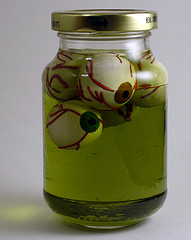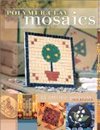Halloween Tutorial: Eyeballs in a Jar
 Need one more thing to make your Halloween decor complete? Try this quick and easy project! Polymer clay eyeballs float in a jar of colored water to make a delightfully weird conversation piece for your home or office.
Need one more thing to make your Halloween decor complete? Try this quick and easy project! Polymer clay eyeballs float in a jar of colored water to make a delightfully weird conversation piece for your home or office.
Materials
- Polymer Clay: White Ultralight Sculpey plus tiny amounts of black. red. and any color of your choice
- Jar
- Food Coloring
- Water
- Optional: Alcohol Inks, Pasta Machine, Clay Extruder, Small Round Cookie Cutter, Kato Clear Liquid Medium
Instructions
 Form clay eyeballs. Use white Ultralight Sculpey to make two matching balls for the eyeballs. The advantage of using Ultralight Sculpey over other brands is that it's lightweight enough to float after baking. However, it's also very soft and can be tricky to work with. I made one eyeball with half Premo, half Ultralight, and it floated just fine — so try experimenting with different mixtures.
Form clay eyeballs. Use white Ultralight Sculpey to make two matching balls for the eyeballs. The advantage of using Ultralight Sculpey over other brands is that it's lightweight enough to float after baking. However, it's also very soft and can be tricky to work with. I made one eyeball with half Premo, half Ultralight, and it floated just fine — so try experimenting with different mixtures.A note on floating: My first batch of eyeballs floated iris-side up — which is not ideal for viewing from the jar's side. After some further test, I found that whichever way I baked them is how they tended to float. So you should be fine if you bake yours as shown in the photos. If not, another trick is to add a weight (such as a core made from a heavier clay) towards to bottom to help it float right.
 Cut out irises. Use a pasta machine to roll out a very thin sheet of whatever color clay you want your irises to be, then cut two matching circles using a small round cookie cutter. If you don't have a pasta machine, use an acrylic brayer, jar, or clay-dedicated rolling pin. A small circle template will work in place of the cookie cutter.
Cut out irises. Use a pasta machine to roll out a very thin sheet of whatever color clay you want your irises to be, then cut two matching circles using a small round cookie cutter. If you don't have a pasta machine, use an acrylic brayer, jar, or clay-dedicated rolling pin. A small circle template will work in place of the cookie cutter.Optional: Irises are rarely a solid color. If you're going for a more realistic look, try adding gradiations and specks of color. One way to do this is to dab the piece with alcohol inks before baking. A Skinner blend would also work.
 Make pupils. Measure out two very small balls of black. I rolled mine out on a pasta machine, then used a small cookie cutter to ensure I got the same amount for each pupil. Now roll these into a ball and smash them slightly into a disk. Press them into the center of the irises.
Make pupils. Measure out two very small balls of black. I rolled mine out on a pasta machine, then used a small cookie cutter to ensure I got the same amount for each pupil. Now roll these into a ball and smash them slightly into a disk. Press them into the center of the irises. Assemble eyeballs. Add the pupil/iris to the eyeball, gently reshaping the eyeball if necessary.
Assemble eyeballs. Add the pupil/iris to the eyeball, gently reshaping the eyeball if necessary. Add blood-shot lines. I used my clay extruder's smallest disk to create the red "blood-shot" strands on the eyeball. I first traced the veins I planned to follow with a needle tool, then pressed pieces of the long red strand into the indentions, using my thumbnail to snip off strands once they were long enough. If you're going for a more subtle look, you could just trace the lines before baking, then come back with acrylic paint and antique it after baking. (Of course, if you're going for subtle, this project may not be for you!) You'll probably want to seal it with something like Kato Clear Medium afterwards, though — just in case the acrylic paint you're using doesn't hold up well to its new watery home.
Add blood-shot lines. I used my clay extruder's smallest disk to create the red "blood-shot" strands on the eyeball. I first traced the veins I planned to follow with a needle tool, then pressed pieces of the long red strand into the indentions, using my thumbnail to snip off strands once they were long enough. If you're going for a more subtle look, you could just trace the lines before baking, then come back with acrylic paint and antique it after baking. (Of course, if you're going for subtle, this project may not be for you!) You'll probably want to seal it with something like Kato Clear Medium afterwards, though — just in case the acrylic paint you're using doesn't hold up well to its new watery home. Bake. Bake the eyeballs on a layer of polyfill to prevent flat and shiny spots.
Bake. Bake the eyeballs on a layer of polyfill to prevent flat and shiny spots. Assemble jar. Place water in the jar until it's as full as you like. Add a couple of drops of food coloring (I used green, but brown or yellow would also look cool). Drop in your eyeballs and you're done!
Assemble jar. Place water in the jar until it's as full as you like. Add a couple of drops of food coloring (I used green, but brown or yellow would also look cool). Drop in your eyeballs and you're done!
Variations & Links
- Add an antiqued label to the jar. You can go for laughs ("Spare Parts") or chills ("Last Year's Trick-or-Treaters")
- What's spookier than finding a body part in a jar? Finding a body part in a rusted jar! I mean, who knows how long that old thing's been down in the basement! Use Sophisticated Finishes Rust Antiquing Set
to add an easy rusted look to any lid.
- Martha Stewart has a video tutorial for making specimen jars. Her special twists? Spooky lighting and black ice. [Thanks to Noadi for the link — be sure to check out Noadi's very cool sea creatures in a jar.]
- You're not limited to eyeballs. Try making your jar with toes, severed fingers, or vague shapes (a la the "Thing in a Jar").
Here's hoping you have a fun and safe Halloween!



